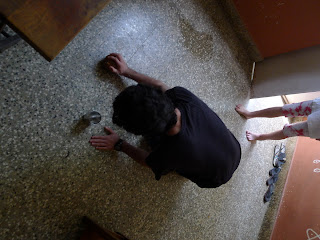 |
| Lord Ganesha in the waters off Chowpatty Beach, Bombay |
 |
| Buying the flowers at the local market |
 |
| Eco-friendly clay Ganeshas |
 |
| Fresh garlands of flowers |
 |
| Fruits and leaves to adorn the Ganesh statue |

Some of these statues can be several metres high and each village or locality builds the biggest Ganesha they can afford in a sort of ethereal contest of the town’s spiritual worth. The bigger statues have to be lowered into the water off the back of trucks with cranes especially installed for the festival. In Bombay, where we lived for a couple of years, more than a million people crowd Chowpatty Beach to see the final immersion of the Ganesh statues.
Our ritual is a little more low key. We always buy an eco-friendly Ganesh made of clay ... which dissolves easily in water ... unlike many of the giant plaster statues which, along with the often garish oil-based paint used to decorate them, are a major pollution problem once the festival is over.
 |
| Preparing the table |
 |
| Lighting the incense |
 |
| Breaking the coconut |
 |
| Our Ganesh statue will stay with us for 10 days |
 |
| Happy Ganesh Chaturthi! |
I have this fabulous baking book called “Classic Home Desserts: A Treasury of Heirloom and Contemporary Recipes”, written by an American writer and cookbook author Richard Sax. It’s a compendium of mostly American dessert recipes – though many are influenced by early migrant families from across Europe – and is an engaging mix of recipes, historical and anecdotal notes about cooks and quotes from literary works across 200 years of American and English history. It was first published in 1994 and won many awards before being republished a few years ago. (Sadly, Richard Sax died in 1995 from lung cancer at the age of 46.)
One of the standout recipes in the book is called “A Semolina Ring Cake from Friuli”; Friuli is Italy’s most north-eastern region (the Italian filmmaker Pier Paolo Pasolini was born there) and has its own distinctive food culture. This recipe, which is over 100 years old, found its way into the book via an Italian chef’s grandmother.
 |
| My Italian semolina ring cake |
So this is what we had at the end of dinner last Wednesday night ... an historic Italian semolina cake to celebrate Lord Ganesha’s birthday!
SEMOLINA RING CAKE FROM FRIULI
Ingredients:
2/3 C blanched or unblanched almonds ¾ C semolina flour 1 C sugar grated zest of 1 lemon – 2 in India as they are too small 6 eggs, separated pinch salt icing sugar for topping Plus eggnog custard with rum (Recipe also says you can serve it with fresh strawberries but they are not in season here.)
Method:
Preheat oven to 180C degrees . Butter and flour a cake tin – preferably a round bundt pan.
Grind the almonds, flour and sugar in a food processor until powdery and then add lemon zest and all of the egg yolks. Blend and set aside.
 |
| The batter after mixing in the beaten eggwhites |
Beat the egg yolks and salt in a bowl until they nearly form stiff peaks. Fold into the semolina- almond mixture and pour into the cake tin. Bang the tin on a surface several times to settle the batter.
Bake the cake until top is lightly golden ... about 40 minutes worked for me. Cool cake, run knife around edge of tin, invert onto another plate or cake stand. Top with the icing sugar & serve with custard or icecream.
Note: suggest you find a custard recipe you are familiar with and add 1 ½ tablespoons of dark rum. Me? ... I fucked the custard up completely by overcooking it and making it curdle ... which is why I am not showing you a picture of it ... and is also why my dear departed mother would be utterly ashamed of me!
Nevertheless, the cake was an absolute classic ... beautifully light with a lemony almond aftertaste. If you can’t make the custard serve it with icecream ... and have a dark rum and soda instead ... that’s what I did.
Tony saab, Hyderabad Sept 2012

.jpg)










